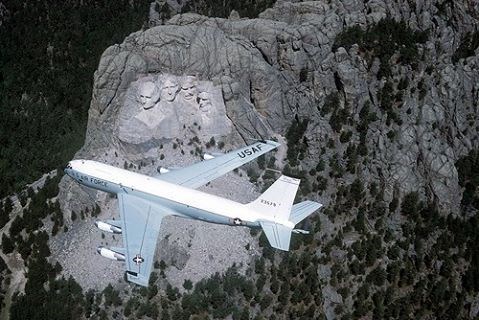Last updated: February 8, 2024
Article
The Airborne Command Post System

USAF Photo
The Strategic Air Command Airborne Command Post System and Its Connection to Minuteman Missiles
Ranger Jim Boensch
1/31/2024
The mission of Strategic Air Command’s (SAC) airborne command post system was to be a visible deterrent to the Soviet Union throughout the Cold War. It was the single platform that combined the latest Command Control Communications and elite crews that assured connectivity between missileers, aircrews and the President of the United States. This program added real meaning to SAC’s motto “Peace is our Profession”.
The first and most famous example of SAC Airborne Command Posts (ABNCP) was a modified C-135 aircraft and crew, call sign “Looking Glass”, so named because its mission was to mirror the capabilities of the SAC underground command post. When it first launched on February 3, 1961, it began a story that lasted almost thirty years – airborne alert 24/7 over the central United States with an Air Force general and battle staff. This survivable system later expanded into the Post Attack Command Control System (PACCS), which provided a fleet of EC-135 aircraft and crews forming an airborne communications chain from Washington, D.C. to all missile fields. The SAC ABNCP and PACCS were also a part of the World Wide Airborne Command Post System which also included the National Emergency Airborne Command Post (NEACP) and the airborne command posts in Europe and those covering the Atlantic and Pacific Oceans. Together, they insured that all nuclear forces, including Navy submarines, received emergency action messages.
With the SAC ABNCP on airborne alert all the time, our enemies could not concentrate their weapons on SAC Headquarters, Air Force command posts or other communication centers and prevent our nuclear forces from receiving Presidential authority to use nuclear weapons. By the mid-1960s, the improved accuracy of Soviet ballistic missiles had increased the vulnerability of our buried Minuteman launch control centers (LCC). SAC’s answer to this challenge was the Airborne Launch Control System (ALCS), which gave us a highly survivable, alternate launch capability for the Minuteman Missile. The first ALCS launch of a Minuteman was successfully conducted at Vandenberg Air Force Base (AFB), California, on April 17, 1967. Soon thereafter, the ALCS was installed aboard the SAC ABNCP and PACCS aircraft assigned to Ellsworth AFB, SD and Minot AFB, ND. Minuteman missiles could now be launched from the air, using a UHF radio signal. During peacetime, ALCS crews had no access to nuclear armed missiles, except for testing, which was normally conducted weekly. The ground missile crews had to be destroyed or give access for the ALCS crew to take over launch actions. The 4th Airborne Command Control Squadron (4ACCS) was formed at Ellsworth AFB on April 1, 1970. The ALCS crews formerly assigned to the 44th Strategic Missile Wing (SMW) at Ellsworth and the 91st SMW at Minot were assigned to 4ACCS as a part of the 28th Bomb Wing at Ellsworth. The aircraft assigned to the 4ACCS, along with the aircraft assigned to SAC ABNCP duties at Offutt AFB, NE, were now the only aircraft in the United States Air Force (USAF) capable of launching any or all of our 1,000 Minuteman missiles. Our leaders deemed the PACCS so important that they gave take-off/launch priority to PACCS aircraft over nuclear armed aircraft in emergency situations.
Four EC-135 aircraft manned by crews from 4ACCS were always on alert and capable of immediate launch. Two of these aircraft, ALCC-1 and the West Auxiliary Command Post (WAUXCP), were on alert at Ellsworth AFB; the other two aircraft, ALCC-2 and ALCC-3, were deployed to Minot AFB for alert duty on a rotational basis, usually changing crews once a week. ALCC-1 was responsible for covering the missile fields at Ellsworth AFB and F.E. Warren AFB, WY. The WAUXCP was a backup to the SAC ABNCP and otherwise a spare ALCS aircraft. ALCC-2 covered Malmstrom AFB, Montana. ALCC-3 had responsibility to back up the Minot and Grand Forks missile fields. “Looking Glass” covered the Whiteman AFB, MO Minuteman Wing.
On July 24, 1990, after 29 years of continuous airborne operations, the SAC ABNCP “Looking Glass” completed its last continuous airborne alert flight. A new modified alert concept was adopted, involving random “Looking Glass” flights on a regular basis, with the aircraft being on ground alert the remainder of the time. Although 24-hour airborne alert operations had ceased, the basic mission remained unchanged.
The year 1991 saw many significant changes for PACCS and ALCS. The 4th ACCS discontinued deployed alerts to Minot AFB in August and began preparations for deactivation the following year. At the end of September, the WAUXCP and all three ALCC aircraft went off alert shortly after President Bush took the bomber force and half of the missile force off strategic alert. Since then, there have been numerous changes to our nation’s strategic airborne command post system. On June 1, 1992, after 46 years, SAC was deactivated and U.S. Strategic Command (USSTRATCOM) was activated. The Air Force continued to perform the “Looking Glass” mission until October 1, 1998, when the U.S. Navy’s fleet of TACAMO (“Take Charge and Move Out”) E-6Bs replaced the EC-135. A newer aircraft, the E-6B consolidated Air Force, Navy and STRATCOM nuclear command and control. “Looking Glass”-specific equipment was installed on the E-6Bs and the aircraft now stand alert and fly with a multi-service Battle Staff headed by a general/admiral.
The success of the “Looking Glass” mission is a tribute to the men and women that made it happen. SAC won the Cold War for America and “Looking Glass” and its PACCS partners were key components in that victory.
